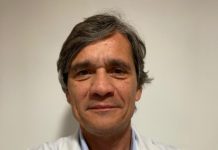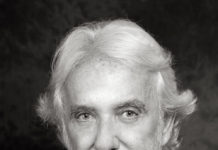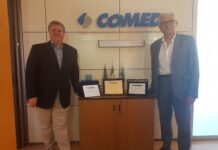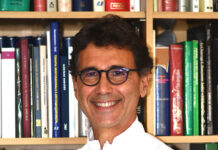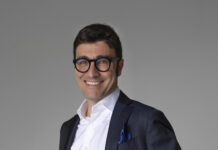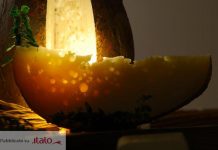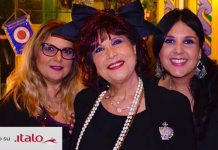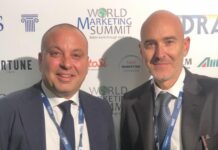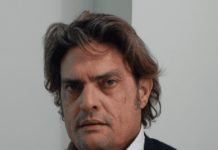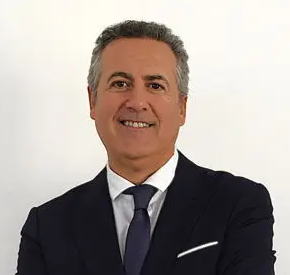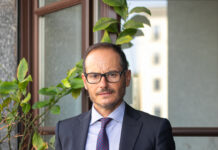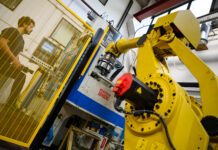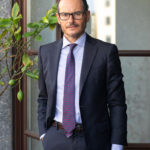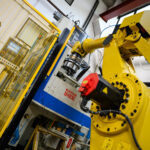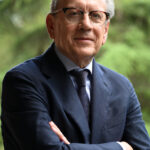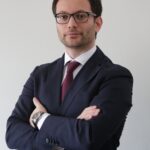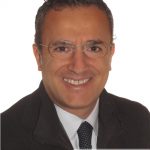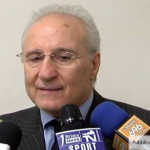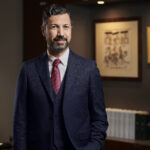Oscar Di Domenico shares his vision for a project that aims to bring a deserted village in the Marche region back to life, blending heritage preservation, technological innovation, and understated luxury. At the same time, his studio is expanding globally with a new international headquarters, bringing Italian excellence to the world.
by Roberta Imbimbo
Architect, could you tell us how this project was conceived and what makes it unique within the landscape of Italian historic village restoration?
This project, still in the presentation phase, was born from a deep connection with the Marche region and from an awareness of its immense, often silent and endangered heritage. It involves an abandoned village in Pieve Torina, located in the seismic crater area of the Marche — a naturally stunning place that has gradually fallen silent due to earthquakes and depopulation. Our goal is not just to restore it, but to reactivate it — to awaken its soul. The approach is both “tailor-made” and “holistic”: every building, alley, and stone will be analyzed to recover its original function and reinterpret it in a contemporary way. It’s not a tourist stage set, but a living organism where homes, a scattered hotel, workshops, and community spaces coexist in harmony.
What are the main technical and architectural challenges in transforming an entire village into a luxury residence and scattered hotel?
The challenges are numerous and constant. The first concerns seismic strengthening of ancient, irregular, and complex buildings. Then comes the integration of advanced technologies — smart systems, climate control, and connectivity — within historic walls, without compromising their aesthetic integrity. Finally, there’s the logistical complexity of managing a widespread construction site with limited access, requiring maximum respect for the surrounding context.
How do you reconcile the preservation of historical heritage with the comfort and service expectations of a high-end international clientele?
Through the philological preservation of exteriors and a “controlled contamination” of interiors. We use local materials and traditional techniques, combined with contemporary design and technology. Light, stone, wood, and natural fabrics create a whispered, authentic luxury — where preservation becomes not a constraint, but an added value.
What kind of foreign investors are you targeting, and what opportunities does the Italian experiential tourism market offer?
We are addressing cultural, not speculative, investors — people who understand the value of beauty, history, and sustainability. Experiential tourism is rapidly expanding: today’s travelers seek authenticity, a connection with the land, and experiences rooted in gastronomy, craftsmanship, and tradition. Reviving a village means offering not just accommodation, but an authentic Italian way of life.
How important is integration with the local area — traditions, food and wine, landscape — for the success of a project like this?
It’s fundamental — I’d say it represents 90% of the project’s success. The village will serve as a gateway to the Marche region’s excellence, in collaboration with local winemakers, artisans, and chefs. The goal is to create an integrated ecosystem where guests experience the landscape and culture not as spectators, but as active participants.
The brand “ODD & Partners Architects – Oscar Di Domenico Architetto” and the new international headquarters
Why did you decide to adopt a renewed and more international brand identity?
The new brand, Di Domenico Architects, represents the natural evolution of our studio and its expansion into the global market. It maintains a strong link with our identity while speaking a universal language — reflecting a complex structure and a multidisciplinary team capable of managing high-profile international projects.
What values and vision do you want to convey through “Di Domenico Architects”?
The core values remain the same: roots — with respect for historical and landscape context; innovation — through sustainable and technological solutions; and craftsmanship. The tailor-made approach reflects my personal background — I come from a family of fashion entrepreneurs, where I learned that every creation must be unique, designed around the client’s needs and the spirit of the place. Our vision is to be ambassadors of an architectural Made in Italy, not just as a style but as a working method — one that blends creativity, attention to detail, and advanced engineering.
Where will the new international headquarters be located, and why was that destination chosen?
We chose Tirana for its strategic position as a global hub for luxury real estate and international investment. It’s a crossroads of cultures and talents that allows us to stay close to clients, partners, and major engineering firms, optimizing project management on a worldwide scale.
How will this international expansion change your studio’s positioning in the global architectural landscape?
It marks the transition from an Italian studio with an international outlook to a truly global one — firmly rooted in Italian tradition. It strengthens our competitiveness in luxury hospitality and high-end residential sectors, allowing us to export our expertise in heritage restoration worldwide.
What international projects are you currently considering, and which markets interest you the most?
We are evaluating luxury resorts, boutique hotels, and private villas in exceptional locations such as the Swiss Alps, the United States, and major European capitals like Paris and London. We’re also interested in Albania and Turkey, where real estate markets are rapidly growing. We aim to bring our Italian know-how to places where quality and craftsmanship are recognized and sought after.
Studio growth and future vision
How is your team structured today, and what new professional roles have you integrated?
The team has grown organically into a multidisciplinary group that includes architects, interior designers, landscape architects, lighting experts, and BIM specialists. We’ve also added professionals focused on business development and international project management to handle complex global relationships and operations.
What organizational model enables you to manage complex, multi-site projects?
We follow a hub-and-spoke model: the Italian office remains our creative and research center, while the international branch serves as the operational and commercial hub. Each project is coordinated by a project leader and managed in real time through digital platforms and shared BIM models.
What kind of international partnerships or collaborations are you building to support your growth?
We collaborate with local architecture and engineering firms in various countries for regulatory management and site supervision, as well as with real estate companies and global luxury hospitality brands. These alliances allow us to access new opportunities while ensuring excellence in project execution.
How does international exposure influence your studio’s design culture and architectural language?
It has a major, positive impact. Engaging with diverse cultures and contexts enriches our design language while preserving our strong Italian identity. Our signature remains attention to detail, material quality, and the continuous dialogue between history and modernity.
Looking ahead, what are your main ambitions — consolidating your presence in Italy or accelerating international expansion?
The two directions complement each other. Italy remains our laboratory of excellence, where we continue to experiment, particularly in the restoration of historic villages. These experiences are our business card abroad and the foundation of our international growth.
If you had to summarize the philosophy connecting the restoration of Italian villages, your new brand, and the studio’s international expansion, what would be the common thread?
The common thread is the idea of “beauty that creates value.” Whether we are awakening a sleeping Italian village or designing a resort on a foreign coast, our approach is always the same: we start from the unique identity of a place to create extraordinary experiences — and, consequently, enduring value. Restoring villages has taught us to work with the soul of places. The new brand, Di Domenico Architects, communicates this sensibility to a global audience. International expansion is the natural outcome of this vision — exporting not just an architectural style, but a working method that places culture, history, and quality at its core, transforming them into a strategic asset for the future. Ultimately, we build bridges between past and future, between local and global.












